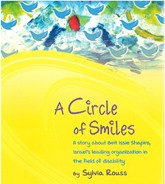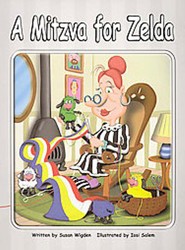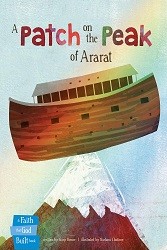This book is so gorgeous that within ten minutes of seeing my early review copy, I contacted the artist and bought the cover art to have framed and placed on the wall of our temple library. I hadn’t read the book yet, but it didn’t matter. The cover illustration depicts a plaintive white ram in midleap, bounding out of paradise on his way to his mission of self-sacrifice. That sad-eyed, heroic ram spoke to me from between the loving “hands” of God, who made him “on the last day of the Creation, in the twilight of the first Sabbath.” And there he is again, on the book’s opening page, nestled within God’s hands, floating above the newly created world, waiting for his moment.
In the peaceful beauty of the Garden of Eden, the lonely ram waits. Adam and Eve and all the other creatures have left the garden, and ages have passed, but still he waits for God to wake him and tell him that his time has come. When he is finally called upon by God, he runs from the garden and encounters the “evil one” who is depicted as taking many clever forms in order to foil the ram’s intention. These forms include a red devil, a field of inviting green grass, a cool, sparkling fountain, and a fierce lion. Each time the ram encounters the “evil one” he is not dissuaded from his goal: “I must save the child!” he repeats, and the story takes on a true sense of urgency. When the ram arrives at the sacred mountain, he sees a “child tied and bound on an altar, and a weeping man.” “Wait!” the ram cries, “I am here! Take me!” Then God asks Abraham to remove his son from the altar, and God says, “I wanted the whole world to see your love and your trust in me, so that all people might follow your example.” Abraham then frees the struggling ram, who is caught in the brambles, and the ram leaps onto the altar and speaks. “Abraham,” says the proud but doomed ram, “On Rosh Hashanah, blow through one of my horns, and God will hear the sound and remember Isaac and me, the white ram that took his place. And He will forgive the sins of Isaac, and his children, and his children’s children’s children, always, till the end of time.” We then turn to the amazing two-page spread of the sacrificed ram, in shadow on the altar, as his soul flies “into God’s hands.”
Gerstein has included depictions of God (and especially, God’s hands) within the illustrations of the sky. If this is an issue for Jewish readers, it is addressed in the author’s note as follows: “In the illustrations, following the Jewish tradition that God may not be pictured, I used the empty spaces between clouds to suggest images of His hands, and even His face. See if you can find them.” I found this artistic vision to be particularly comforting, especially the “hands” of God cradling the lone white ram on his first day of life.
Is this story too sad for children? I would guess that for some, the idea of the beautiful white ram sacrificing himself on the altar while Abraham clasps his weeping, relieved son to his breast would certainly be a problem. But not all illustrated books for children are for all ages. Biblical stories contain mighty themes, and many parents would never consider the Akedah story to be suitable for young children. But in Gerstein’s version of this midrash, the ram’s selfless act of sacrifice contributes to subsequent Jewish history: his ashes are made into the mortar for the altar of the Temple, his innards are made into the ten strings of David’s harp, and his hide provides Elijah’s cape. Lastly, two brightly illustrated seraphim are depicted blowing the two shofars that were made from his horns. The author writes, “One was blown when Moses received the Ten Commandments. And the other will call the children of Israel home.”
This book is about the act of remembering. It is about how thankful we are for those who have sacrificed for us, whether they are parents, children, teachers, friends, or even beloved and devoted animals that have served us so faithfully. It is a truly ecumenical story, and would be universal to all belief systems, even though certain Christological references can be gleaned from the text. The pacing of the text is perfect, and the moving illustrations, done in pen and ink, oils, and colored pencil, are mesmerizing. This book has received much praise and many starred reviews in the secular children’s press. What a pleasure it is to see a book based on a Jewish midrash get that kind of recognition! The author has mastered a perfect combination of story and illustration and we are truly thankful for his efforts.





